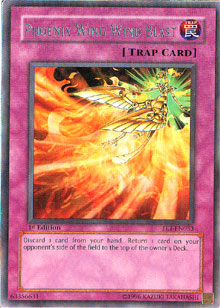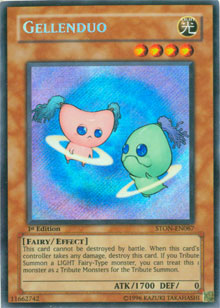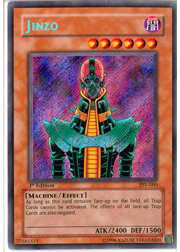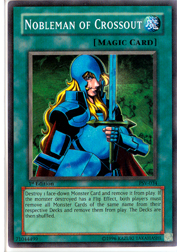Hello Metagame readers. My name is Brian Bodkin, although many of you probably know me by my online alias, OraCLe. This is my first article as a Metagame.com writer, and my goal is to fervently increase the talent pool of this game in both the minds of successful, tournament-winning players and those who are still working at it. I hope that no matter how good a player you are, you can extract some piece of information from this article. After all, we all play the same game: why not add to the knowledge pool? The focus of my writings here will be individual cards that have the ability to innovate current, highly-played decks. The deck I will be looking at today is Perfect Circle Monarchs.
I’m sure that most duelists who come to Metagame.com or go to Shonen Jump Championships are all too familiar with this deck type. I want to take a look at this specific archetype because I feel that certain cards out there can benefit it. Too often we overlook things, and identifying other alternatives is the first step to becoming better deckbuilders. Perfect Circle Monarchs is an obvious powerhouse in the game today, but it’s definitely not a flawless deck. Its exploding build capitalizes on being granted more card options thanks to cards like Elemental Hero Stratos, Destiny Draw, and Destiny Hero - Disk Commander. This deck also contains a lot of support to quickly sift through options thanks to cards like Destiny Draw. That ensures that you can access a wide range of options and outs left in the deck, letting you advance the stages of the game.
 One of the big themes of Perfect Circle Monarchs is its uncanny ability to develop and maintain game position. Game position does not necessarily have to coincide with having more options than the opponent. Case in point: if I have Jinzo on the field and two cards in my hand, while my opponent’s hand numbers six cards, it’s theoretically possible that the opponent’s hand contains either all traps, or a mix of traps and dead cards. I have fewer options than the opponent, but my position in the game is still stronger. With that notion established, we can take a more critical look at some aspects of the Perfect Circle Monarchs strategy.
One of the big themes of Perfect Circle Monarchs is its uncanny ability to develop and maintain game position. Game position does not necessarily have to coincide with having more options than the opponent. Case in point: if I have Jinzo on the field and two cards in my hand, while my opponent’s hand numbers six cards, it’s theoretically possible that the opponent’s hand contains either all traps, or a mix of traps and dead cards. I have fewer options than the opponent, but my position in the game is still stronger. With that notion established, we can take a more critical look at some aspects of the Perfect Circle Monarchs strategy.
With use of Raiza the Storm Monarch and Phoenix Wing Wind Blast on the rise, this concept is very relevant to the Yu-Gi-Oh! TCG as it currently stands. Perfect Circle Monarchs largely draws upon spin mechanics (the act of returning a card from the field to the top of your opponent’s deck) to neutralize options the opponent may want to draw into. This deck also exploits many draw effects such as those of Destiny Hero - Disk Commander and Destiny Draw. However, given the nature of this strategy, are there any cards that can make it even more successful? In my honest opinion, I believe so.
Innovating the Deck: Gellenduo
Gellenduo might be a confusing pick at first glance. It is a 1700 ATK stall monster—what could it possibly do to contribute to a deck that is constantly pressing to make attacks? The answer lies in one of the main functions of the deck: Gellenduo helps to maintain or develop game position. Many Perfect Circle Monarchs decks are running Marshmallon and Spirit Reaper, so why not Gellenduo? It has the potential to attack for 1700 damage, and it can also sit there for turns on end while you gather more options. You can use that time to assess the game state and gain ground. This format nurtures the strategy of spinning cards to control what your opponent draws. Who wants to spin Marshmallon or Spirit Reaper? Unless a duelist is going for game, he or she will be in the same exact position a turn later when you set that monster again, and the only discrepancy is likely to be a difference in life points. The same theory holds for Gellenduo.
 The more you force the opponent into spinning cards that maintain field presence (or using other options to do so), the fewer outs and options he or she will have later. This only adds to the Perfect Circle player’s control over the game, and applying this theory will add to your success as a duelist.
The more you force the opponent into spinning cards that maintain field presence (or using other options to do so), the fewer outs and options he or she will have later. This only adds to the Perfect Circle player’s control over the game, and applying this theory will add to your success as a duelist.
I myself used a Perfect Circle variant with Gellenduo to much success. With the Perfect Circle mirror match being so common, Gellenduo gives you a most definite edge. It's a prime example of a high-utility card that happens to serve a commonly played deck to a great extent. This underrated Fairy-type exploits every underlying theory and principle behind Perfect Circle Monarchs: it provides you with more options while limiting those of your opponent. Gellenduo controls the field like Marshmallon and Spirit Reaper, and serves as a great topdeck, especially in a format where fewer and fewer permanent outs to it (besides Gadgets) are being run. Although cards like Soul Exchange and Zaborg the Thunder Monarch have risen in play, your opponent is depending on those cards to deal with the situation . . . assuming the opponent runs them at all.
Innovating the Deck: Jinzo
Secondly, what about Jinzo? A card we were blessed with at the dawn of Pharaoh's Servant, he quickly shot up in use in early formats. His ability to completely shut out an important element of the game system by negating traps was compared to Imperial Order (the difference being that Imperial Order was optional, while Jinzo was not). Imperial Order put the spell game in your control, while Jinzo shuts traps down on both ends. It has since dropped in popularity for the most part, unfortunately. When people think of tribute monsters that affect the game on a huge level, Monarchs and Light and Darkness Dragon almost always come to mind. Those cards have proven successful in Shonen Jumps, and Jinzo hasn’t had that kind of widespread exposure for quite some time.
 However, Jinzo and Gellenduo operate on such a fantastic level. Jinzo faces a weakness Gellenduo doesn’t: he isn’t an ideal topdeck. He can be spun with Raiza and your game position is compromised almost surely, which isn’t the case with Gellenduo. Jinzo requires presence of mind to be played effectively. His value comes in the way he restricts your opponent’s tactics, and ultimately the cards he or she plays as well.
However, Jinzo and Gellenduo operate on such a fantastic level. Jinzo faces a weakness Gellenduo doesn’t: he isn’t an ideal topdeck. He can be spun with Raiza and your game position is compromised almost surely, which isn’t the case with Gellenduo. Jinzo requires presence of mind to be played effectively. His value comes in the way he restricts your opponent’s tactics, and ultimately the cards he or she plays as well.
When you force opponents to deal with your cards to get back into playing their game, and you have control over their plays, you’ve found a card that can fill a very rare role. Jinzo goes toe-to-toe with almost any monster commonly played. Despite the fact that this game urges us to run bigger trap lineups, Jinzo’s negation and simplification abilities will always be invaluable. The current trend right now is to run 40-41 cards in the average main deck, with six to eight traps. Given these two figures, we can expect that one in every five to six-and-a-half cards the opponent draws will be a trap. The fact that people don’t typically play a trap each turn also plays a role in Jinzo’s success. Players conserve cards. This has been true since the Traditional format, and remains a pivotal point to understand. It’s our nature as players to attempt to use cards to their fullest potential, and conservation allows for this. This also allows Jinzo to be heavily explosive.
Gellenduo has the potential to affect highly competitive metagames. It is a wonderful card that supports many deck types because it runs parallel with many of this game’s theories and allows for easy adaptation. Jinzo is a bit more complicated to play, but effectively erases one mechanic from the game. He is a better attacker than Gellenduo, due to the limitations on Gellenduo’s survival. Jinzo also serves as a prime target for cards such as Premature Burial and Call of the Haunted. The take-home message with Jinzo is that you must weigh the card and field presence of certain effects against the lockdown potential of others. Do you want to take a card out of your opponent’s hand or destroy your opponent’s monster? Or do you want to effectively manipulate the cards your opponent will play in the future? Both are practical and useful given the nature of competitive metagames right now, but both must be looked at objectively and differently as they fill different niches.
 On a much more critical note, observe the successful decks early in this format. You’ll notice that cards like Nobleman of Crossout, Lightning Vortex, Creature Swap, and Smashing Ground saw much more play than they had over the past few Jumps. This is proof that the competitive metagame is constantly evolving. Since the game is constantly reshaping itself, newer strategies and card choices must be evaluated. Gellenduo and Jinzo may be ideal for today, but they may not be as good in the future. Bottom line is that it’s important to recognize that metagames always change, and that changes can occur quickly or slowly. The important thing is to realize this, and adapt with decks and card choices to optimize our success and progress, and to get better in that process.
On a much more critical note, observe the successful decks early in this format. You’ll notice that cards like Nobleman of Crossout, Lightning Vortex, Creature Swap, and Smashing Ground saw much more play than they had over the past few Jumps. This is proof that the competitive metagame is constantly evolving. Since the game is constantly reshaping itself, newer strategies and card choices must be evaluated. Gellenduo and Jinzo may be ideal for today, but they may not be as good in the future. Bottom line is that it’s important to recognize that metagames always change, and that changes can occur quickly or slowly. The important thing is to realize this, and adapt with decks and card choices to optimize our success and progress, and to get better in that process.
So the next time you think of successful alternate cards for your Perfect Circle Monarchs deck, I ask you to keep a variety of options in mind: just like Gellenduo and Jinzo. If we truly wish to improve our skill in this game, we need to make an effort to become more open to new concepts and cards. I hope that you all enjoyed reading this article. Until next time, take care and have fun with the game.
—Brian Bodkin